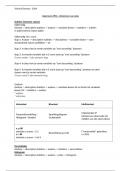Summary
Samenvatting Volledig stappenplan SPSS Statistiek IV (18/20)
- Course
- Institution
Dit is een volledige handleiding waarin er stap per stap uitgelegd wordt wat er uitgevoerd moet worden in SPSS per WPO-hoofdstuk. Telkens staan de mogelijke conclusies en interpretaties ook toegevoegd en welk antwoord er op het examen gegeven moet worden. Ik heb dit schema volledig gevolgd op mijn ...
[Show more]



